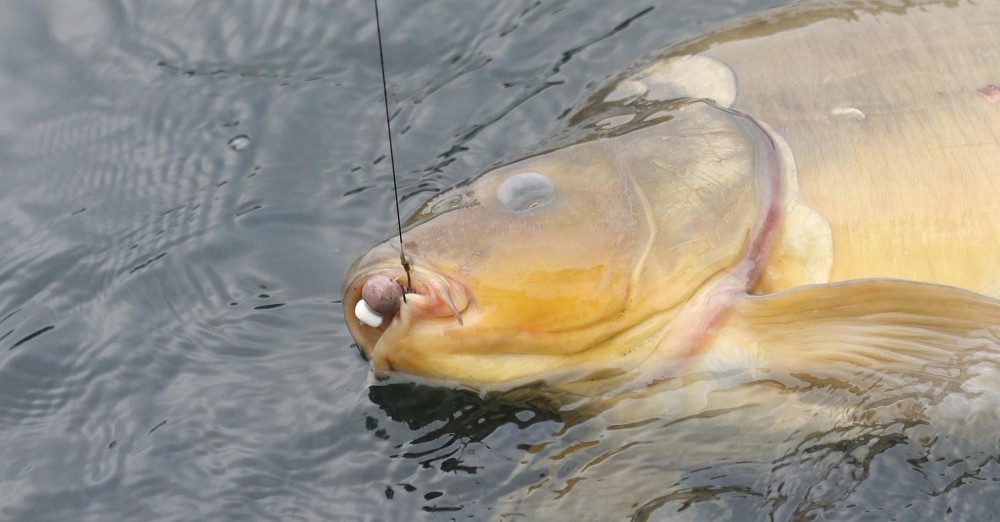
A critical bait or over-weighted pop-up?
We ask our team of experts...
QUESTION: Critically-balanced baits, that is a bait that will just sink when it has broken the surface tension of the water have been acclaimed as catching out the wary, invective carp, and yet when a fish swims by, these ‘critical baits’ will fly up into the baited area, stopping at the point to where they are tied to the lead, in other words the length of the rig. Bearing this in mind, would you opt for a ‘critical bait’ over an ‘over-weighted pop-up’ which is not so blatantly in the face if disturbed by feeding fish?
Lewis Read
“IT REALLY DOES DEPEND ON THE ANGLING SITUATION AT THE TIME”
“The choice on how balanced you set your hookbaits is probably best related to time of year and baiting strategy. I certainly believe that there are distinct advantages in critical-balancing when you’re fishing single hookbaits, a wide scattering of boilies in open water or when the water temperature is low. In these circumstances I think you want to give the hookbait every opportunity to take a slow moving carp by surprise by flying up into the fishes mouth when it is inhaled. The rest of the time, boilie hookbaits are just ‘slow sinking’ rather than ‘critically-balanced’ as I tend to fish them over just (WHOLE) boilie. This is irrespective of whether the pop-up is mounted on a HSR or a Multi Rig – the same rule of thumb applies as balancing is controlled by the rig mechanics too.
“My personal experience is that over-weighted Hinged Rigs tend to sit over awkwardly (like having the hook section too long) and would rather use an alternative rig in these circumstances – something lower where the putty is on the lakebed, not a swivel length’s height above it.
“When it comes to balanced bottom bait rigs (like the Clone and German), I balance hookbaits so the hook lies flat on the bottom with the hookbait hovering over the top – now that’s ultimate rig camouflage. You can effectively hide a big hook like a size 4 Mugga under a relatively small hookbait – try it, you’ll be surprised. This is just enough balance to ensure the hookbait reacts quickly when inhaled – but not so light that it wafts about as a bulky fish approaches.
“In the winter I may sometimes balance it more (with a longer hooklink) in silt – but I worry about the hook point being dinked if I am fishing on gravel as the hookbait may move about a bit. It’s easy to fine-tune balancing rigs with a bit of Critical Mass Putty and a coil of fly tiers lead wire. “Fine-tuning your rigs not only controls the way the hookbait and hook lies and the way the hooklink lays out but also the speed the rig reacts. It’s certainly worth experimenting to find the best option with your preferred rigs.”
Martin Locke
“Over-weighted is an edge”
“There are loads of ways to catch a carp, wary or otherwise. Critically-balanced hookbaits are another highly popular and successful method in which to do so. In theory, the visible, floating, weightless hookbait should be the best method by far, after all, you have the ‘not really feeding’ factor i.e. carp swims over baited area and there is a hookbait wafting about and they can’t help but suck it in, so a take from nothing = a bonus fish. When they are feeding and ‘fanning’ the baited area, lots of particles, baits and silt cloud suspended and slow sinking, with a hookbait that sinks even slower, again, would you expect that you’d get a take?
“However, we’ve all seen how carp react over bait and they can appear to be not as bright as we think they are, by seeming to be oblivious to the pop-up (critically-balanced or otherwise, or just plain avoiding it.). I’d like to think they’re not that smart, as by now, after all the years of being caught on ‘hovering’, unnatural looking baits, they still fall for the method time and time again.
“The over-weighted pop-up is a brilliant and often overlooked method. The man himself, Danny Smith, put me wise to it during a session we fished at Redmire Pool. It was obvious as soon as he said it. At the time there was this ‘candy floss’ – the cling-on, ‘fluff-ball’ type weed about, the stuff that sticks to everything, and often, unknown to the angler until he/she winds in, making your presentation practically useless! A critically-balanced bait to sit on top of it you’d think was ‘the one’, but Dan knew better and proved it. For example, if the hooklink is say, eight-inches long, then the radius of movement is 16-inches, so the hook can ‘sweep’ around until it catches on some ‘floss’. But if you overweight the hookbait, but still leave it one-inch from the bottom, the movement radius is now only two-inches… obvious now eh? Coupled with the fact that the weight pulled the hooklink down under the fish’s bottom lip also adds to the hooking as there is less chance of the fish ejecting it.
“Bingo, it worked a treat on The Mere and subsequently on my next session the following week to the Herts Club Lake where I had a year’s worth of fish in a day – nine to 47lb! Food for thought eh!”




